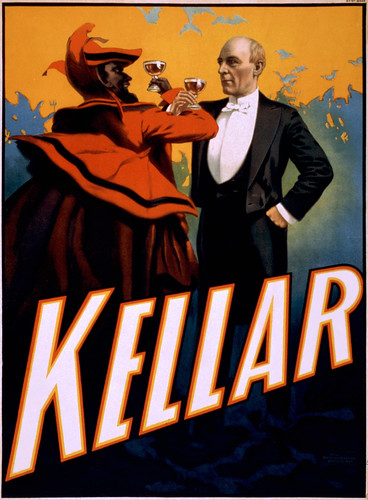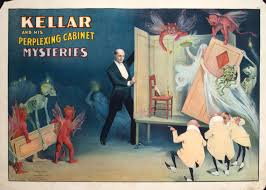The "Dean of American Magicians," Harry Kellar (July 11, 1849 – March 3, 1922) was one of the great American Magicians of the turn of the century, whose legacy and influence can be clearly seen today in the acts of contemporary magicians worldwide. He enjoyed a long and brilliant career, thrilling and amazing audiences with his ability to make objects materialize, levitate and disappear.
 Harry (Heinrich Keller) was a daring and mischievous child who loved playing chicken with passing trains and experimenting with different chemicals to make explosions during his childhood in Pennsylvania.
Harry (Heinrich Keller) was a daring and mischievous child who loved playing chicken with passing trains and experimenting with different chemicals to make explosions during his childhood in Pennsylvania.
As per the wishes of his German immigrant parents, Heinrich became an apprentice to a pharmacist. After accidentally blowing a hole in the floor of the pharmacy following a mixture-gone-wrong, Heinrich hopped a train and ran away to begin life as a vagabond.
Kellar was working on a farm in Buffalo New York, when one evening he went to see a performance of a traveling magician, The Fakir of Ava (the stage name of Isiaiah Harris Hughes), and "immediately got the urge to go on the stage." Kellar's passion for conjuring had been ignited. He answered an ad placed by Hughes for an assistant, and got the job. Kellar attempted his first solo performance at the age of 16.
 In 1869, Kellar took a job with "The Davenport Brothers and Fay," a group of stage spirtualists made up of Ira Erastus Davenport, William Henry Davenport and William Fay. Kellar toured with the company all over Central and South America and enjoyed great financial success.
In 1869, Kellar took a job with "The Davenport Brothers and Fay," a group of stage spirtualists made up of Ira Erastus Davenport, William Henry Davenport and William Fay. Kellar toured with the company all over Central and South America and enjoyed great financial success.In 1875, the tour ended in Rio de Janeiro and with an appearance before Emperor Dom Pedro II. Sadly, Kellar's luck was to soon take a turn for the worse, and on his way to a tour in England, the ship Kellar was sailing on, the Boyne, sank in the Bay of Biscay. Lost in the wreckage was Keller's entire fortune, his show, clothes, and jewels. Kellar was left with only the clothes on his back and a diamond ring he was wearing. Even worse, his bankers in New York cabled him telling him that his bank had failed. Desperate for money, Kellar sold his ring, while Fay left to rejoin the Davenports.
Kellar spent the very last of his money to buy an illusion he had seen performed by magicians Maskelyne and Cooke at their theatre the Egyptian Hall. Upon his return to the United States, Kellar started a troupe of his own, and a theatre based on Maskelyne and Cook's, also called Egyptian Hall.
 In 1878, Kellar returned to England and spent a fortune of more of Maskelyne and Cook illusions and tricks and the appropriate equipment. Shortly before arriving, Kellar was told of the death of magician Robert Heller. Kellar was soon embroiled in controversy with the American public after being accused by the New York Sun of pirating the name in order to profit from it. Kellar tried to prove that his name has always been Keller and that he even changed it so as not to be confused with Heller.
In 1878, Kellar returned to England and spent a fortune of more of Maskelyne and Cook illusions and tricks and the appropriate equipment. Shortly before arriving, Kellar was told of the death of magician Robert Heller. Kellar was soon embroiled in controversy with the American public after being accused by the New York Sun of pirating the name in order to profit from it. Kellar tried to prove that his name has always been Keller and that he even changed it so as not to be confused with Heller.
He also pointed out that Heller had changed his name from William Henry Palmer. The damage was done however and his sullied public image caused Kellar to eventually cancel his upcoming shows in the United States and head back to Brazil.
During another World Tour in 1882, Kellar met an avid and beautiful young fan named Eva in Melbourne, who came backstage to get his autograph. They became penpals and wrote to eachother for the next five years.
 Kellar returned to his Egyptian Hall in December 1884, on Chestnut Street in Philadelphia, Pennsylvania and enjoyed 264 popular performances. During this time Eva came to visit Kellar and began to play the Cornet in his show. She began to learn the business of Magic alongside Kellar, and they were married on November 1st, 1887. Eva went on to become Kellar's assistant, appearing in many of his famous illusions including the "Levitation of Princess Karnac."
Kellar returned to his Egyptian Hall in December 1884, on Chestnut Street in Philadelphia, Pennsylvania and enjoyed 264 popular performances. During this time Eva came to visit Kellar and began to play the Cornet in his show. She began to learn the business of Magic alongside Kellar, and they were married on November 1st, 1887. Eva went on to become Kellar's assistant, appearing in many of his famous illusions including the "Levitation of Princess Karnac."
On October 1891 Kellar opened his second Egyptian Hall at Concert Hall, located also on Chestnut Street. After a highly successful seven month run, Kellar decided to return to the road.
Kellar retired on May 16, 1908 with his last show at Fords Theater in Baltimore. He handed over the mantle of America's Greatest Magician to Howard Thurston.
On November 11, 1917, Harry Houdini arranged for Kellar to perform once more for a show benefitting families of the men who died when the troop transport vessel Antilles was sunk by a German U-boat. Never one for understatement, Houdini arranged for Kellar to be carried off stage in triumph as six thousand spectators sang Auld Lang Syne. This would end up being Harry Kellar's final public performance.
Kellar died on March 10, 1922. He is buried at Angelus Rosedale Cemetery in Los Angeles. His grave marker reads"Beloved Dean of Magic."
 |
Harry Kellar
|
Kellar’s “Levitation of Princess Karnac”
In this illusion, Kellar hypnotizes a woman dressed in a Hindu costume, and she reclines on a couch. As Kellar waves his arm she rises, until she is six feet up. The couch is removed and a ring is passed around her body to prove that there are no wires.
Another version built by Kellar was purchased by Harry Blackstone Sr who used the trick for many years. The Trick was described as a marvel of the twentieth century and the "crowning achievement of Mr. Kellar's long and brilliant career." 
“The Nested Boxes”
Kellar borrows six finger rings from members of audience. He loads them into the barrel of a pistol, aims and fires the pistol at a chest that is hanging on the side of the stage. The chest is opened and inside is another, smaller chest. Inside that, are six boxes nested in each other.
As each is opened, they are stacked on top of each other and inside the smallest one are the five rings each tied with ribbon to flowers. The five rings are returned to their owners. The owner of the sixth ring wonders what happened to hers, with Kellar pretending not to notice.
He continues with his next trick, which a variation of Robert-Houdin’s “Inexhaustible Bottle”. Audience members call out different beverages like wine, whiskey, lemonade, or just water.
Each one is poured from the same bottle and the audience acknowledges that they are indeed receiving their requested drinks. Once bottle is empty, Kellar takes it and breaks it open. Inside is a guinea pig with a sash around its neck which has the sixth ring attached to it. The ring is eventually handed back to its owner.
 A variation of the trick was performed in front of United States President Theodore Roosevelt and his children, Ethel, Archie, Quentin and Kermit. Ethel was the owner of the sixth ring and after Kellar had returned her ring, he asked if she would also like to have the guinea pig as a pet. Then Kellar wrapped the guinea pig in paper and handed it back to Ethel. When it was opened, inside was a bouquet of pink roses.
A variation of the trick was performed in front of United States President Theodore Roosevelt and his children, Ethel, Archie, Quentin and Kermit. Ethel was the owner of the sixth ring and after Kellar had returned her ring, he asked if she would also like to have the guinea pig as a pet. Then Kellar wrapped the guinea pig in paper and handed it back to Ethel. When it was opened, inside was a bouquet of pink roses.“The Vanishing Lamp”
A lamp is seen set on top of a glass table. Still lit, Kellar covers the lamp with a thin cloth. Kellar told the audience that each evening, the lamp would be returned to its purported, original owner in India at a specific time.
As a bell sounded out the current time of day, Kellar loaded a pistol and aimed it towards the lamp. At the last chime, Kellar fired the pistol. The lamp seemed to melt away, with the cloth falling to the stage. Kellar was known to have a short temper and after an incident where the “Vanishing Lamp” failed to vanish, an assistant had set it up on the stage to try and repair it. Kellar saw the lamp and decided to take an ax to it.
Kellar eventually built another one that would continually work and, long after his retirement, the lamp he built still worked perfectly.
 Back in the 1960s there were plans to put a motorway down through the middle of the cemetery, following the valley. Despite huge protests the tombstones were moved further up the hills and the bodies were largely left below, not to the knowledge of the general public.
Back in the 1960s there were plans to put a motorway down through the middle of the cemetery, following the valley. Despite huge protests the tombstones were moved further up the hills and the bodies were largely left below, not to the knowledge of the general public.






















































